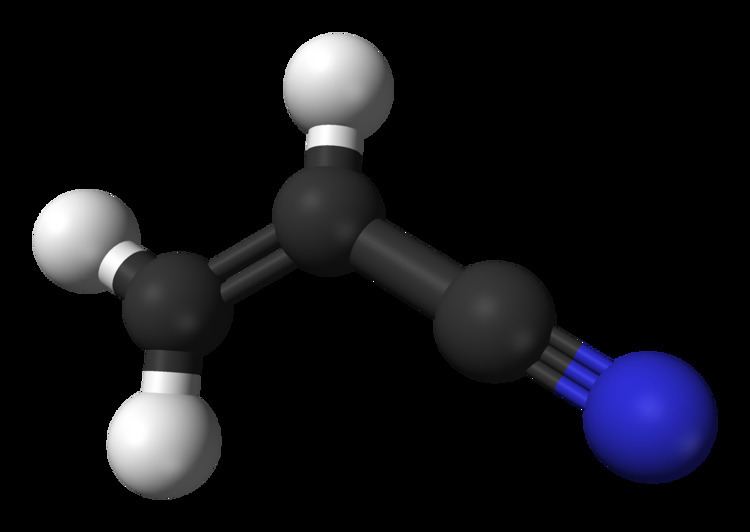Appearance Colourless liquid Formula C3H3N Boiling point 77 °C | Related compounds Density 810 kg/m³ Melting point -84 °C | |
 | ||
Similar Acetonitrile, Polyacrylonitrile, Acrylamide | ||
Acrylonitrile butadiene styrene
Acrylonitrile is an organic compound with the formula CH2CHCN. It is a colorless volatile liquid, although commercial samples can be yellow due to impurities. In terms of its molecular structure, it consists of a vinyl group linked to a nitrile. It is an important monomer for the manufacture of useful plastics such as polyacrylonitrile. It is reactive and toxic at low doses. Acrylonitrile was first synthesized by the French chemist Charles Moureu (1863–1929) in 1893.
Contents
- Acrylonitrile butadiene styrene
- Production
- Emerging Industrial Routes
- Uses
- Health effects
- Environmental effects
- References

Production
Acrylonitrile is produced by catalytic ammoxidation of propylene, also known as the SOHIO process. In 2002, world production capacity was estimated at 5 million tonnes per year. Acetonitrile and hydrogen cyanide are significant byproducts that are recovered for sale. In fact, the 2008–2009 acetonitrile shortage was caused by a decrease in demand for acrylonitrile.
2CH3-CH=CH2 + 2NH3 + 3O2 → 2CH2=CH-C≡N + 6H2O
In the SOHIO process, propylene, ammonia, and air (oxidizer) are passed through a fluidized bed reactor containing the catalyst at 400–510 °C and 50–200 kPag. The reactants pass through the reactor only once, before being quenched in aqueous sulfuric acid. Excess propylene, carbon monoxide, carbon dioxide, and dinitrogen that do not dissolve are vented directly to the atmosphere, or are incinerated. The aqueous solution consists of acrylonitrile, acetonitrile, hydrocyanic acid, and ammonium sulfate (from excess ammonia). A recovery column removes bulk water, and acrylonitrile and acetonitrile are separated by distillation. Historically, one of the first successful catalysts was bismuth phosphomolybdate supported on silica as a heterogeneous catalyst. Further improvements have since been made.
Emerging Industrial Routes

Various green chemistry routes are being developed for the synthesis of acrylonitrile from renewable feedstocks, such as lignocellulosic biomass, glycerol (from biodiesel production), or glutamic acid (which can itself be produced from renewable feedstocks). The lignocellulosic route involves fermentation of the biomass to propionic acid and 3-hydroxypropionic acid which are then converted to acrylonitrile by dehydration and ammoxidation. The glycerol route begins with pyrolysis to acrolein, which undergoes ammoxidation to give acrylonitrile. The glutamic route employs oxidative decarboxylation to 3-cyanopropanoic, followed by a decarbonylation-elimination to acrylonitrile. Of these the glycerol route is broadly considered to be the most viable, although current methods are still unable to compete with the SOHIO process in terms of cost.
Uses
Acrylonitrile is used principally as a monomer to prepare polyacrylonitrile, a homopolymer, or several important copolymers, such as styrene-acrylonitrile (SAN), acrylonitrile butadiene styrene (ABS), acrylonitrile styrene acrylate (ASA), and other synthetic rubbers such as acrylonitrile butadiene (NBR). Dimerization of acrylonitrile affords adiponitrile, used in the synthesis of certain polyamides. Small amounts are also used as a fumigant. Acrylonitrile and derivatives, such as 2-chloro-acrylonitrile, are dienophiles in Diels-Alder reactions. Acrylonitrile is also a precursor in the industrial manufacture of acrylamide and acrylic acid.
Health effects
Acrylonitrile is highly flammable and toxic at low doses. It undergoes explosive polymerization. The burning material releases fumes of hydrogen cyanide and oxides of nitrogen. It is classified as a Class 2B carcinogen (possibly carcinogenic) by the International Agency for Research on Cancer (IARC), and workers exposed to high levels of airborne acrylonitrile are diagnosed more frequently with lung cancer than the rest of the population. It evaporates quickly at room temperature (20 °C) to reach dangerous concentrations; skin irritation, respiratory irritation, and eye irritation are the immediate effects of this exposure.
Acrylonitrile increases cancer in high dose tests in male and female rats and mice.
Pathways of exposure for humans include emissions, auto exhaust, and cigarette smoke that can expose the human subject directly if they inhale or smoke. Routes of exposure include inhalation, oral, and to a certain extent dermal uptake (tested with volunteer humans and in rat studies). Repeated exposure causes skin sensitization and may cause central nervous system and liver damage.
There are two main excretion processes of acrylonitrile. The primary method is excretion in urine when acrylonitrile is metabolized by being directly conjugated to glutathione. The other method is when acrylonitrile is metabolized with 2-cyanoethylene oxide to produce cyanide end products that ultimately forms thiocyanate, which is excreted via urine, or carbon dioxide and eliminated through the lungs. Metabolites can be detected in the blood and urine.
Acrylonitrile induces apoptosis in human umbilical cord mesenchymal stem cells
Environmental effects
Acrylonitrile is harmful to aquatic life.
